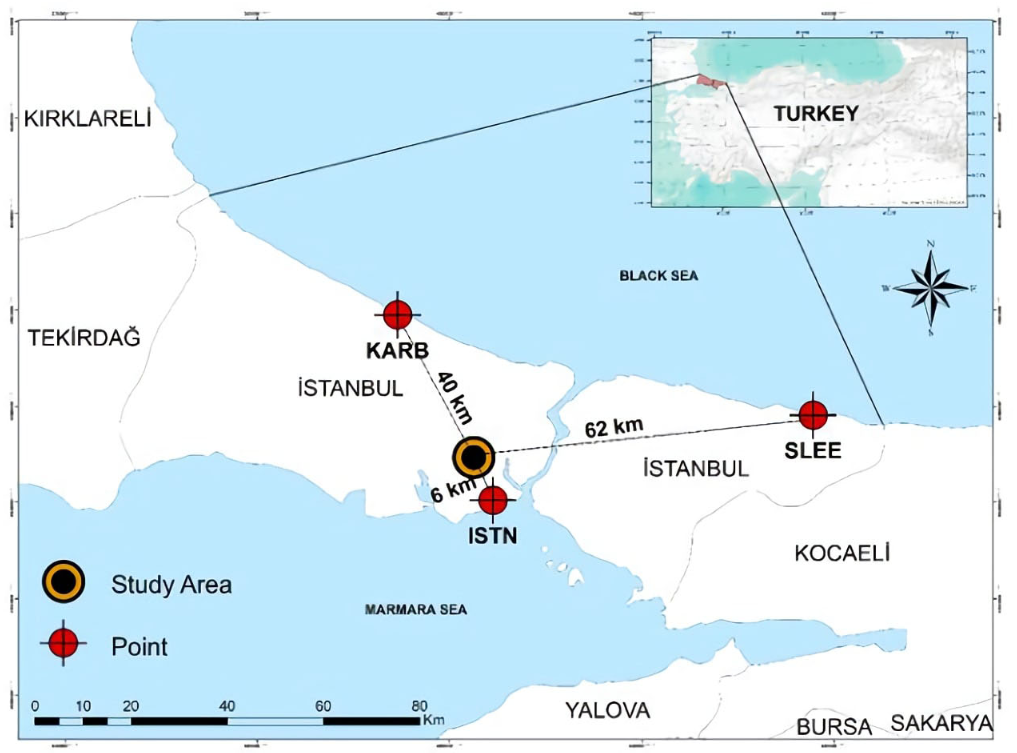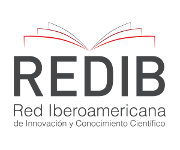
Published
Studying the Repeatability of Measurements Obtained via Network Real-Time Kinematic Positioning at Different Times of the Day
Estudio de la repetibilidad de mediciones obtenidas mediante posicio-namiento cinemático de red en tiempo real para diferentes momentos del día
DOI:
https://doi.org/10.15446/ing.investig.105622Keywords:
ANOVA, FKP, MAC, NRTK, static GNSS, VRS (en)ANOVA, FKP, MAC, GNSS estático, VRS (es)
Downloads
The network real-time kinematic (NRTK) positioning technique is currently used in numerous applications. The aim of this study was to better understand the process of obtaining accurate positions by statistically evaluating the significance of differences between repeated measurements for a single point at different times of the day (morning, noon, and evening) using the Virtual Reference Station (VRS), Flächen Korrektur Parameter (FKP), and Master Auxiliary Concept (MAC) correction methods. An analysis of variance (ANOVA) was used to this effect. Further analysis was carried out to determine the accuracy and precision of the coordinate differences obtained via a static GNSS (global navigation satellite system) and by averaging the repeated measurements. It was determined that the accuracy and precision of the vertical component of the coordinates were lower than that of the horizontal component. The FKP correction method yielded the best results. It was observed that the accuracy and precision of the measurements taken at noon were the lowest. The ANOVA showed that the differences between repeated measurements were statistically significant and that there were outlier measurements. The results of this study are important for NRTK users to be able to statistically evaluate different measurement configurations and obtain positions with the desired accuracy and precision.
La técnica de posicionamiento cinemático de red en tiempo real (NRTK) se utiliza actualmente en numerosas aplicaciones. El objetivo de este estudio fue comprender mejor el proceso de obtención de posiciones precisas evaluando estadísticamente la importancia de las diferencias entre mediciones repetidas para un solo punto en diferentes momentos del día (mañana, mediodía y tarde), utilizando los métodos de corrección de Estación Virtual de Referencia (VRS), Parámetro de Corrección de Área (FKP) y Concepto Maestro Auxiliar (MAC). Para ello, se utilizó un análisis de varianza (ANOVA). Se realizaron análisis adicionales para determinar la exactitud y la precisión de las diferencias de coordenadas obtenidas mediante un GNSS (sistema global de navegación por satélite) estático y promediando las mediciones repetidas. Se determinó que la exactitud y la precisión del componente vertical de las coordenadas eran menores que las del componente horizontal. El método de corrección FKP proporcionó los mejores resultados. Se observó que la exactitud y la precisión de las mediciones realizadas al mediodía eran las más bajas. El ANOVA mostró que las diferencias entre mediciones repetidas eran estadísticamente significativas y que había mediciones atípicas. Los resultados de este estudio son importantes para que los usuarios de NRTK puedan evaluar estadísticamente diferentes configuraciones de medición y obtener posiciones con la exactitud y precisión deseadas.
References
Basaran, M. (2019). CBS 1 - ek - projeksiyon koordinat sistemleri ve coğrafi bilgi sistemi ortamında kullanımı, Yıldız Teknik Üniversitesi Akademik Veri Yönetimi. https://avesis.yildiz.edu.tr/mbasaran/dokumanlar
Bisnath, S., Saeidi, A., Wang, J. G., and Seepersad, G. (2013). Evaluation of Network RTK performance and elements of certification – A Southern Ontario case study. Geomatica, 67(4), 243-251. https://doi.org/10.5623/cig2013-050
Brown, N. E. (2006). Sequential phased estimation of iono-spheric path delays for improved ambiguity resolution over long GPS baselines [PhD thesis, University of Melbourne].
Brown, N., Geisler, I., and Troyer, L. (2006). RTK rover perfor-mance using the Master Auxiliary Concept. Journal of Glob-al Positioning Systems, 5(1-2), 135-144. DOI: https://doi.org/10.5081/jgps.5.1.135
Brown, N., Keenan, R., Rıchter, B., and Troyer, L. (2005). Ad-vances in ambiguity resolution for RTK applications using the new RTCM V3.0 Master-Auxiliary messages [Conference presentation]. ION GNSS 2005, Long Beach, CA, USA.
Cannon, M. E., Lachapelle, G., Fortes, L. P., Alves, P., and Townsend, B. (2001). The use of multiple reference station VRS for precise kinematic positioning [Conference presenta-tion]. Japan Institute of Navigation, GPS Symposium 2001, Tokyo, Japan.
Chen, X. M., Han, S. W., Rizos, C., and Goh, P. C. (2000). Improving real-time positioning efficiency using the Singa-pore integrated multiple reference station network (SIMRSN) [Conference presentation]. 13th International Technical Meeting of the Satellite Division of The Institute of Navigation (ION GPS 2000), Salt Lake City, UT, USA.
Cina, A., Dabove, P., Manzino, A. M., and Piras, M. (2015). Network Real Time Kinematic (NRTK) Positioning - Description, Architectures and Performances. In S. Jin (Eds.), Satellite Po-sitioning – Methods, Models and Applications (pp. 23-45). IntechOpen. https://doi.org/10.5772/59083
Colombo, O. L., Hernández-Pajares, M., Juan, J. M., Sanz, J., and Talaya, J. (1999). Resolving carrier phase ambiguities on the fly, at more than 100 km from nearest reference site, with the help of ionospheric tomography [Conference presenta-tion]. 12th International Technical Meeting of the Satellite Division of The Institute of Navigation (ION GPS 1999), Nash-ville, TN, USA.
Dabove, P., Manzino, A. M., and Taglioretti, C. (2014). GNSS network products for post-processing positioning: Limitations and peculiarities. Applied Geomatics, 6, 27-36. https://doi.org/10.1007/s12518-014-0122-3
Dai, L., Han, S. W., Wang, J. L., and Rizos, C. (2001). A study on GPS/GLONASS multiple reference station technique for precise realtime carrier phase-based positioning [Confer-ence presentation]. 14th International Technical Meeting of the Satellite Division of The Institute of Navigation (ION GPS 2001), Salt Lake City, UT, USA.
Dardanelli, G., Maltese, A., Pipitone, C., Pisciotta, A., and Lo Brutto, M. (2021). NRTK, PPP or static, that is the question. Test-ing different positioning solutions for GNSS survey. Remote Sensing, 13(7), 1406. https://doi.org/10.3390/rs13071406
Davis, J. L., Herring, T. A., Shapiro, I. I., Rogers, A. E., and Elgered, G. (1985). Geodesy by radio interferometry: Effects of atmospheric modelling errors on estimates of baseline length, Radio Science, 20, 1593-1607. https://doi.org/10.1029/RS020i006p01593
Eren, K., Uzel, T., Gulal, E., Yildirim, O., and Cingoz, A. (2009). Results from a comprehensive Global Navigation Satellite System test in the CORS-TR network: Case study. Journal of Surveying Engineering, 135(1), 10-18. https://doi.org/10.1061/(ASCE)0733-9453(2009)135:1(10)
Euler, H. J., Keenan, C. R., Zebhauser, B. E., and Wübbena, G. (2001). Study of a simplified approach in utilizing information from permanent reference station arrays [Conference presentation] ION GPS-01, Salt Lake City, UT, USA.
Euler, H. J. (2006). Real-time RTK messages for permanent reference station applications standardized by RTCM [Con-ference presentation]. IAG Symposium, Munich, Germany.
Gao, Y., Li, Z., and McLellan, J. F. (1997). Carrier phase based regional area differential GPS for decimeter-level positioning and navigation [Conference presentation]. ION GPS-97: 10th International Technical Meeting of the Satellite Division of the Institute of Navigation, Kansas City, MO, USA.
Gandolfi, S., Tavasci, L., and Poluzzi, L. (2017). Study on GPS-PPP precision for short observation sessions. GPS solu-tions, 21, 887-896. https://doi.org/10.1007/s10291-016-0575-4
Garrido, M. S., Giménez, E., Lacy, M. C., and Gil, A. J. (2011). Testing precise positioning using RTK and NRTK corrections provided by MAC and VRS approaches in SE Spain. Journal of Spatial Science, 56(2), 169-184. https://doi.org/10.1080/14498596.2011.623341
Garrido, M. S., de Lacy, M. C., and Rojas, A. M. (2018). Impact of tropospheric modelling on GNSS vertical precision: An empirical analysis based on a local active network. International Journal of Digital Earth, 11(9), 880-896. https://doi.org/10.1080/17538947.2017.1367040
Ge, M., Gendt, G., Rothacher, M. A., Shi, C., and Liu, J. (2008). Resolution of GPS carrier-phase ambiguities in precise point positioning (PPP) with daily observations. Journal of Geode-sy, 82(7), 389. https://doi.org/10.1007/s00190-007-0187-4
Gumus, K. (2016). A research on the effect of different measuring configurations in Network RTK applications. Measurement, 78, 334-343. https://doi.org/10.1016/j.measurement.2015.10.022
Gumus, K., and Selbesoglu, M. O. (2019). Evaluation of NRTK GNSS positioning methods for displacement detection by a newly designed displacement monitoring system. Measurement, 142, 131-137. https://doi.org/10.1016/j.measurement.2019.04.041
Gökdaş, Ö., and Özlüdemir, M. T. (2020). A variance model in NRTK-based geodetic positioning as a function of baseline length. Geosciences, 10(7), 262. https://doi.org/10.3390/geosciences10070262
Grejner-Brzezinska, D. A., Kashani, I., and Wielgosz, P. (2005). On accuracy and reliability of instantaneous network RTK as a function of network geometry, station separation and data processing strategy. GPS Solutions, 93, 179-193. https://doi.org/10.1007/s10291-005-0130-1
Han, S. W. (1997). Carrier phase-based long-range GPS kine-matic positioning [PhD thesis, University of New South Wales]. DOI: https://doi.org/10.1007/978-3-662-03482-8_94
Hu, G. R., Khoo, H. S., Goh, P. C., and Law, C. L. (2003). De-velopment and assessment of GPS virtual reference stations for RTK positioning. Journal of Geodesy, 77(5), 202-302. https://doi.org/10.1007/s00190-003-0327-4
Janssen, V. (2009). A comparison of the VRS and MAC princi-ples for network RTK [Conference presentation]. IGNSS Sym-posium, Surfers Paradise, Queensland, Australia.
Janssen, V., Grinter, T., and Roberts, C. (2011). Can RTK GPS be used to improve cadastral infrastructure? Engineerıng Jour-nal, 15(1), 43. https://doi.org/10.4186/ej.2011.15.1.43
Jin, S. (Ed.) (2012). Global navigation satellite systems: Signal, theory and applications. Books on Demand. DOI: https://doi.org/10.5772/1134
Kahveci, M., Alioglu, D., and Çetin, G. (2021). Tek frekansli GNSS alıcılarında kullanılan iyonosferik etki düzeltme model-lerinin karşılaştırılması. Konya Journal of Engineering Scienc-es, 9(2), 428-441. https://doi.org/10.36306/konjes.849391
Kalaycı, Ş. (2010). SPSS uygulamali çok değişkenli istatistik teknikleri. Asil yayin dağitim Ltd. Şti.
Klobuchar, J. A., and Doherty, P. H. (1990). The statistics of ionospheric time delay for GPS ranging on L1 [Conference presentation]. ION GPS-90, 3rd International Technical Meet-ing of the Satellite Division of the Institute of Navigation, Colorado Springs, CO, USA.
Kudrys, J., and Krzyek R. (2011). Analysis of coordinates time series obtained using the NAWGEO service of the ASG-EUPOS system. Geomatics and Environmental Engineering, 5(4), 39-46.
Kun, S., and Yong, W. (2006). The development and applica-tion of CORS technology and its value in the solution for en-vironment protect in the GMS. GMSARN International Jour-nal, 1, 69-74. https://gmsarnjournal.com/home/wp-content/uploads/2015/08/vol1no2-3.pdf
Landau, H., Vollath, U., and Chen, X. (2002). Virtual reference station systems. Journal of Global Positioning Systems, 1(2), 137-143. DOI: https://doi.org/10.5081/jgps.1.2.137
Landau, H., Vollath, U., and Chen, X. (2003). Virtual reference stations versus broadcast solutions in network RTK – Ad-vantages and limitations [Conference presentation]. GNSS 2003 – The European Navigation Conference, Graz, Austria.
Leica Geosystems (2005). Networked Reference Stations: Take it to the MAX. Leica Geosystems.
Li, X., Ge, M., Dai, X., Ren, X., Fritsche, M., Wickert, J., and Schuh, H. (2015). Accuracy and reliability of multi-GNSS real-time precise positioning: GPS, GLONASS, BeiDou, and Gali-leo. Journal of geodesy, 89(6), 607-635. https://doi.org/10.1007/s00190-015-0802-8
Lin, M. (2006). RTCM 3.0 Implementation in network RTK and performance analysis [Master’s thesis, University of Calgary]. http://hdl.handle.net/1880/101496
Martin, A., and McGovern, E. (2012). An evaluation of the performance of network RTK GNSS services in Ireland [Con-ference paper]. https://arrow.tudublin.ie/cgi/viewcontent.cgi?article=1001&context=dsiscon
Öğütcü, S., and Kalaycı, İ. (2018). Accuracy and precision of network-based RTK techniques as a function of baseline dis-tance and occupation time. Arabian Journal of Geoscienc-es, 11, 354. https://doi.org/10.1007/s12517-018-3712-2
Park, B., and Kee C. (2010). The Compact Network RTK Meth-od: An effective solution to reduce GNSS temporal and spa-tial decorrelation error. Journal of Navigation, 63(2), 343-362. https://doi.org/10.1017/S0373463309990440
Pirti, A., Arslan, N., Deveci, B., Aydin, O., Erkaya, H., and Hosbas, R. G. (2009). Real-time kinematic GPS for cadastral surveying. Survey Review, 41(314), 339-351. https://doi.org/10.1179/003962609X451582
Pirti, A., and Hosbas, R. G. (2019). Role of CORS RTK (Network RTK) mode measurements in determination of the forest boundary: A case study of ISKI-CORS. Forestry Ideas, 25(2), 394-403. https://forestry-ide-as.info/issues/issues_Index.php?pageNum_rsIssue=2&totalRows_rsIssue=19&journalFilter=64
Raquet, J. (1998). Development of a method for kinematic gps carrier-phase ambiguity resolution using multiple refer-ence receivers [PhD thesis, University of Calgary].
Rizos, C. (2002). Network RTK research and implementation – A geodetic perspective. Journal of Global Positioning Systems, 1(2), 144-150. DOI: https://doi.org/10.5081/jgps.1.2.144
Tarig, A. (2012). Positioning with wide-area GNSS Networks: Concept and application positioning. Scientific Research, 3, 1-6. https://doi.org/10.4236/pos.2012.31001
Vollath, U., Buecherl, A., and Landau, H. (2000a). Long range RTK positioning using virtual reference stations [Conference presentation]. 2000 National Technical Meeting of The Insti-tute of Navigation, Anaheim, CA, USA.
Vollath, U., Buecherl, A., Landau, H., Pagels, C., and Wagner, B. (2000b). Multi base RTK positioning using virtual reference stations [Conference presentation]. 2000 National Technical Meeting of The Institute of Navigation, Anaheim, CA, USA.
Wanninger, L. (2002). Virtual reference stations for centimeter level kinematic positioning [Conference presentation]. 15th International Technical Meeting of the Satellite Division of The Institute of Navigation (ION GPS 2002), Portland, OR, USA.
Wanninger, L. (2003). Virtual reference stations (VRS). GPS Solutions, 7, 143-144. https://doi.org/10.1007/s10291-003-0060-8
Wei, E., Chai, H., and An, Z. (2006). VRS: virtual observations generation algorithm. Journal of Global Positioning Systems, 5(1-2), 76-81. DOI: https://doi.org/10.5081/jgps.5.1.76
Wielgosz, P., Grejner-Brzezinska, D. A., and Kashani, I. (2003). Network approach to precise GPS navigation [Conference presentation]. 59th Annual Meeting of The Institute of Navi-gation and CIGTF 22nd Guidance Test Symposium, Albu-querque, NM, USA.
Wübbena, G., Bagge, A., Seeber, G., Volker, B., and Hankemeier, P. (1996). Reducing distance dependent errors for real time precise DGPS applications by establishing refer-ence station networks [Conference presentation]. 1996 Na-tional Technical Meeting of The Institute of Navigation, Santa Monica, CA.
Wübbena , G., Bagge, A. and Schmitz, M. (2001). Network based techniques for RTK applications [Conference presen-tation]. GPS JIN 2001, Tokyo, Japan.
Wübbena, G., and Bagge, A. (2002). RTCM Message Type 59-FKP for transmission of FKP. http://www.geopp.com/pdf/geopp-rtcm-fkp59.pdf
How to Cite
APA
ACM
ACS
ABNT
Chicago
Harvard
IEEE
MLA
Turabian
Vancouver
Download Citation
CrossRef Cited-by
1. Carmen Maria Giordano, Valentina Alena Girelli, Alessandro Lambertini, Maria Alessandra Tini, Antonio Zanutta. (2025). UAV Data Collection Co-Registration: LiDAR and Photogrammetric Surveys for Coastal Monitoring. Drones, 9(1), p.49. https://doi.org/10.3390/drones9010049.
2. Carmen Maria Giordano, Valentina Alena Girelli, Alessandro Lambertini, Emanuele Mandanici, Maria Alessandra Tini, Renata Archetti, Massimo Ponti, Antonio Zanutta. (2025). Evaluating Direct Georeferencing of UAV-LiDAR Data Through QGIS Tools: An Application to a Coastal Area. Remote Sensing, 18(1), p.7. https://doi.org/10.3390/rs18010007.
Dimensions
PlumX
Article abstract page views
Downloads
License
Copyright (c) 2024 Kutalmis Gumus

This work is licensed under a Creative Commons Attribution 4.0 International License.
The authors or holders of the copyright for each article hereby confer exclusive, limited and free authorization on the Universidad Nacional de Colombia's journal Ingeniería e Investigación concerning the aforementioned article which, once it has been evaluated and approved, will be submitted for publication, in line with the following items:
1. The version which has been corrected according to the evaluators' suggestions will be remitted and it will be made clear whether the aforementioned article is an unedited document regarding which the rights to be authorized are held and total responsibility will be assumed by the authors for the content of the work being submitted to Ingeniería e Investigación, the Universidad Nacional de Colombia and third-parties;
2. The authorization conferred on the journal will come into force from the date on which it is included in the respective volume and issue of Ingeniería e Investigación in the Open Journal Systems and on the journal's main page (https://revistas.unal.edu.co/index.php/ingeinv), as well as in different databases and indices in which the publication is indexed;
3. The authors authorize the Universidad Nacional de Colombia's journal Ingeniería e Investigación to publish the document in whatever required format (printed, digital, electronic or whatsoever known or yet to be discovered form) and authorize Ingeniería e Investigación to include the work in any indices and/or search engines deemed necessary for promoting its diffusion;
4. The authors accept that such authorization is given free of charge and they, therefore, waive any right to receive remuneration from the publication, distribution, public communication and any use whatsoever referred to in the terms of this authorization.


























